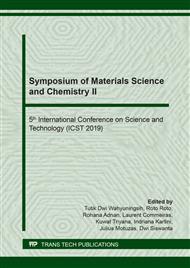[1]
S.H. Omar, N. A. Al-Wabel, Organosulfur compounds and possible mechanism of garlic in cancer, Saudi Pharm. J. 18 (2010) 51–58.
DOI: 10.1016/j.jsps.2009.12.007
Google Scholar
[2]
J.M. Del Valle, C. Mena, M. Budinich, Extraction of garlic with supercritical CO2 and conventional organic solvents, Braz. J. Chem. Eng. 25 (2008) 535–542.
DOI: 10.1590/s0104-66322008000300011
Google Scholar
[3]
F. Li, Q. Li, S. Wu, Z. Tan, Salting-out extraction of allicin from garlic (Allium sativum L.) based on ethanol/ammonium sulfate in laboratory and pilot scale, Food Chem. 217 (2017) 91–97.
DOI: 10.1016/j.foodchem.2016.08.092
Google Scholar
[4]
M.T. Golmakani, M. Moayyedi, Comparison of heat and mass transfer of different microwave-assisted extraction methods of essential oil from Citrus limon (Lisbon variety) peel, Food Sci. Nutr. 3 (2015) 506–518.
DOI: 10.1002/fsn3.240
Google Scholar
[5]
A. Bucić-Kojić, M. Planinić, S. Tomas, M. Bilić, D. Velić, Study of solid-liquid extraction kinetics of total polyphenols from grape seeds, J. Food Eng. 81 (2007) 236–242.
DOI: 10.1016/j.jfoodeng.2006.10.027
Google Scholar
[6]
A. Farhat, A.S. Fabiano-Tixier, F. Visinoni, M. Romdhane, F. Chemat, A surprising method for green extraction of essential oil from dry spices: Microwave dry-diffusion and gravity, J. Chromatogr. A. 1217 (2010) 7345–7350.
DOI: 10.1016/j.chroma.2010.09.062
Google Scholar
[7]
S. Lagergren, About the theory of so-called adsorption of soluble substances, K. Sven. Vetenskapsakademiens Handl. 24 (1898) 1–39.
Google Scholar
[8]
Z. Reddad, C. Gerente, Y. Andres, P. Le Cloirec, Adsorption of several metal ions onto a low-cost biosorbent: kinetic and equilibrium studies, Environ. Sci. Technol. 36 (2002) 2067–(2073).
DOI: 10.1021/es0102989
Google Scholar
[9]
Y.S. Ho, Citation review of Lagergren kinetic rate equation on adsorption reactions, Scientometrics 59 (2004) 171–177.
DOI: 10.1023/b:scie.0000013305.99473.cf
Google Scholar
[10]
Y.S. Ho, H.A. Harouna-Oumarou, H. Fauduet, C. Porte, Kinetics and model building of leaching of water-soluble compounds of Tilia sapwood, Sep. Purif. Technol. 45 (2005) 169–173.
DOI: 10.1016/j.seppur.2005.03.007
Google Scholar
[11]
A.C. Kimbaris, N.G. Siatis, D.J. Daferera, P.A. Tarantilis, C.S. Pappas, M.G. Polissiou, Comparison of distillation and ultrasound-assisted extraction methods for the isolation of sensitive aroma compounds from garlic ( Allium sativum ), Ultrason. Sonochem. 13 (2006) 54–60.
DOI: 10.1016/j.ultsonch.2004.12.003
Google Scholar
[12]
L. Wang, C.L. Weller, Recent advances in extraction of nutraceuticals from plants, Trends Food Sci. Technol. 17 (2006) 300–312.
DOI: 10.1016/j.tifs.2005.12.004
Google Scholar
[13]
Z. Hu, M. Cai, H.H. Liang, Desirability function approach for the optimization of microwave-assisted extraction of saikosaponins from Radix Bupleuri, Sep. Purif. Technol. 61 (2008) 266–275.
DOI: 10.1016/j.seppur.2007.10.016
Google Scholar
[14]
S. Périno-Issartier, Zill-e-Huma, M. Abert-Vian, F. Chemat, Solvent Free Microwave-Assisted Extraction of Antioxidants from Sea Buckthorn (Hippophae rhamnoides) Food By-Products, Food Bioprocess Technol. 4 (2011) 1020–1028.
DOI: 10.1007/s11947-010-0438-x
Google Scholar
[15]
M. Boukroufa, C. Boutekedjiret, L. Petigny, N. Rakotomanomana, F. Chemat, Bio-refinery of orange peels waste: A new concept based on integrated green and solvent free extraction processes using ultrasound and microwave techniques to obtain essential oil, polyphenols and pectin, Ultrason Sonochem. 24 (2015) 72–79.
DOI: 10.1016/j.ultsonch.2014.11.015
Google Scholar
[16]
D.M. Patil, K.G. Akamanchi, Ultrasound-assisted rapid extraction and kinetic modelling of influential factors: Extraction of camptothecin from Nothapodytes nimmoniana plant. Ultrason Sonochem. 37 (2017) 582-591.
DOI: 10.1016/j.ultsonch.2017.02.015
Google Scholar
[17]
M. Vinatoru, An overview of the ultrasonically assisted extraction of bioactive principles from herbs, Ultrason Sonochem. 8 (2001) 303–313.
DOI: 10.1016/s1350-4177(01)00071-2
Google Scholar


